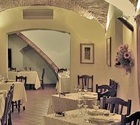The Oratorio di San Biagio has its own page in this website.
Chiesa dell’ Ospedale (1715)
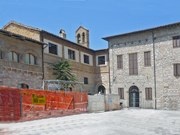
This church and the adjacent hospice belonged to the Confraternita della Nuova Unione, which was formed by the merger of four confraternities (below):
-
✴the Confraternita di San Bernardino;
-
✴the Confraternity di San Giacomo;
-
✴the Confraternita di Santa Maria della Misericordia; and
-
✴the Confraternity di San Michele Arcangelo.
The new church was built on the site of the ancient Chiesa di San Giovanni Decollato, and incorporated the Oratorio di Santa Croce (below) as its sacristy.
The complex passed to the Congregazione della Carità in 1860.
Roman Domus (2nd century AD)
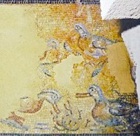
Oratorio di Santa Croce (ca. 1346)
This oratory belonged to the Compagnia della Croce, which was probably established in memory of a miracle that occurred (according to tradition) in 1346, when the factions of Spello fought a battle under the nearby Torre dell’ Olmo (demolished in 1457). This conflict ended abruptly when a cross of fire appeared in the sky, and the erstwhile enemies made peace. (In later versions of the legend, the fight occurred at the instigation of a vicious old lady called Gabrina.)
The Compagnia della Croce merged with the nearby Confraternita di Santa Maria della Misericordia (see below) in 1386.
The Oratorio di Santa Croce stood next to the Chiesa di San Giovanni Decollato. When the latter was rebuilt as Chiesa dell’ Ospedale (see below) in 1715, the oratory was incorporated as its sacristy.
Processional banner (15th century)
This double-sided banner, which belonged to the Compagnia della Croce and the Confraternita della Misericordia, came from the Oratorio di Santa Croce. It is attributed to Pietro di Giovanni Mazzaforte.
-
✴The Madonna della Misericordia on the front of the banner is badly damaged.
-
✴The reverse shows the miracle of the apparition of a cross above Spello: figures of Christ and the Virgin flank the Torre dell’ Olmo looking up at a fiery cross held by angels. Two young men at the foot of the tower (presumably erstwhile combatants) also look up, amazed at the spectacle.
This banner is now in the Pinacoteca Comunale. [It was in restoration in 2009].
Oratorio di San Bernardino (15th Century)
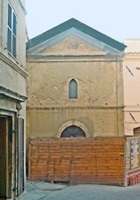
The oratory has been adapted for residential use. Its facade, which was rebuilt in the 18th century, preserves the original portal.
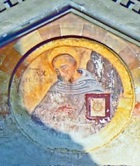
Madonna and Child with saints (1503)
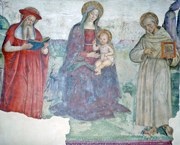
This detached fresco of the Madonna and Child with SS Jerome and Bernardino of Siena i was detached from the oratory early in the 20th century and is now in the Pinacoteca Comunale. The fresco is attributed to Andrea d’ Assisi, l’Ingegno; the date 1503 was probably inscribed on it at the time that it was detached.
Osteriaccia and Oratorio di San Giacomo
The so-called Osteriaccia seems to have been established in the 13th century on the road from Spello to Perugia to provide support for pilgrims travelling between Rome and Santiago di Compostella. (The reason for its unusual name has been lost). It became the property of the Confraternita di San Giacomo. The confraternity built another hospice and an oratory inside the city walls in 1386.
Osteriaccia (ca. 1560-71)
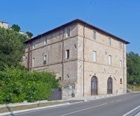

Oratorio di San Giacomo (1386)
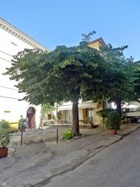
The hospice was closed in 1571. The confraternity survived until 1715, when it was merged with three others (see the Chiesa dell’ Ospedale above). The oratory was deconsecrated in 1773.
The complex was incorporated into the Collegio Vitale Rosi in 1832 and was subsequently adapted as a junior school. Parts of the ex-hospice passed into private ownership in 1990 and now house:
-
✴Bar Tullia (6 Largo Mazzini);
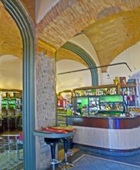
-
✴the Residence San Jacopo (holiday apartments in 1 Via Borgo di Via Giulia).
The Biblioteca Comunale Giacomo Prampolini has occupied part of the complex, including the ex-oratory, since 2007.
Madonna and Child with saints (1594)
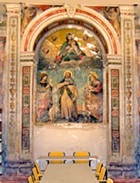
It was while executing this commission in 1594 that il Fantino was called to Sant’ Andrea to sketch an ancient image of the Blessed Andrew Caccioli that was believed to be above his tomb: the image itself was destroyed in order that the relics could be retrieved and formally recognised. Il Fantino provided this information in his evidence in the process for the canonisation of the Blessed Andrew in 1625-7.
Oratorio della Misericordia (1359)
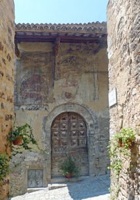
The Confraternita di Santa Maria della Misericordia merged with the nearby Compagnia della Croce (see above) in 1386. The resulting confraternity and its hospice were merged with three others in 1715 (see the Chiesa dell’ Ospedale above).
The oratory passed into private ownership in the 19th century.
Santa Maria della Misericordia (15th century)
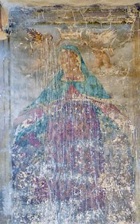
Madonna and Child with saints (1522)
An inscription records that maestro Valentino di Trevi commissioned this fresco in the niche of the altar wall, and records the date. The fresco depicts:
-
✴the Madonna and Child with SS Felix and Antony Abbot;
-
✴God the Father and two angels in the lunette above; and
-
✴to the sides:
-
•the figures of the Annunciation; and
-
•two representations of St Catherine of Alexandria.
Crucifixion ( 1562)
This fresco on the right wall is signed by Michelangelo Carducci di Norcia and dated by inscription.
Other Frescoes
These depict:
-
✴on the altar wall, head of St John the Baptist (16th century);
-
✴on the right wall:
-
•St Roch (16th century);
-
•the Holy Family (1575); and
-
•St Sebastian (16th century); and
-
✴on the counter-facade, Madonna della Misericordia (15th century).
San Michele Arcangelo (14th century ?)
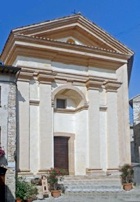
The facade dates to the 17th century.
The church is now deconsecrated.
Death of St Joseph (ca. 1700)
This altarpiece was recorded in San Michele Arcangelo in 1896, with an attribution to Carlo Lamparelli. It is now in the Pinacoteca Comunale, [but not displayed in 2009]
Madonna and Child with saints (early 16th century)
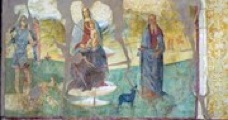
This detached fresco, which depicts the Madonna and Child with SS Michael and Antony Abbot, is now in the chapel adjoining the Cappella del Crocifisso, Santa Maria Maggiore. The artist was a follower of Andrea d' Assisi, l’ Ingegno.
Oratorio di Sant’ Antonio Abate (ca. 1571)
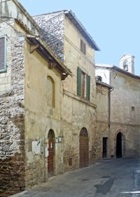
The inscription above the door of the oratory records that it passed to the Societa dei Mulattieri in 1630.
Oratorio della Morte (1623)
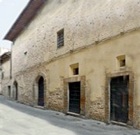
The Compagnia della Morte seems to have owned a cemetery near San Fedele in the 18th century.
God the father with sibyls, prophets and angels (1628)
This Baroque scene is painted on the ceiling.






